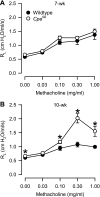Onset of obesity in carboxypeptidase E-deficient mice and effect on airway responsiveness and pulmonary responses to ozone
- PMID: 20299617
- PMCID: PMC2886692
- DOI: 10.1152/japplphysiol.00784.2009
Onset of obesity in carboxypeptidase E-deficient mice and effect on airway responsiveness and pulmonary responses to ozone
Abstract
When compared with lean, wild-type mice, obese Cpefat mice, 14 wk of age and older, manifest innate airway hyperresponsiveness (AHR) to intravenous methacholine and enhanced pulmonary inflammation following acute exposure to ozone (O3). The purpose of this study was to examine the onset of these augmented pulmonary responses during the onset of obesity. Thus airway responsiveness and O3-induced pulmonary inflammation and injury were examined in 7- and 10-wk-old Cpefat and age-matched, wild-type, C57BL/6 mice. Compared with age-matched controls, 7- and 10-wk-old Cpefat mice were approximately 25 and 61% heavier, respectively. Airway responsiveness to intravenous methacholine was assessed via forced oscillation in unexposed Cpefat and wild-type mice. The 10- but not 7-wk-old Cpefat mice exhibited innate AHR. O3 exposure (2 ppm for 3 h) increased markers of pulmonary inflammation and injury in the bronchoalveolar lavage fluid of all mice. However, most markers were greater in Cpefat vs. wild-type mice, regardless of age. Serum levels of leptin, a satiety hormone and proinflammatory cytokine, were increased in Cpefat vs. wild-type mice of both age groups, but the serum levels of other systemic inflammatory markers were greater only in 10-wk-old Cpefat vs. wild-type mice. These results demonstrate that a 25% increase in body weight is sufficient to augment pulmonary responses to O3, but innate AHR is not manifest until the mice become much heavier. These results suggest that the mechanistic bases for these responses are different and may develop according to the nature and degree of the chronic systemic inflammation that is present.
Figures





Similar articles
-
Augmented responses to ozone in obese carboxypeptidase E-deficient mice.Am J Physiol Regul Integr Comp Physiol. 2006 Jan;290(1):R126-33. doi: 10.1152/ajpregu.00306.2005. Epub 2005 Jul 7. Am J Physiol Regul Integr Comp Physiol. 2006. PMID: 16002559
-
Responses to ozone are increased in obese mice.J Appl Physiol (1985). 2003 Sep;95(3):938-45. doi: 10.1152/japplphysiol.00336.2003. Epub 2003 Jun 6. J Appl Physiol (1985). 2003. PMID: 12794034
-
Diet-induced obesity causes innate airway hyperresponsiveness to methacholine and enhances ozone-induced pulmonary inflammation.J Appl Physiol (1985). 2008 Jun;104(6):1727-35. doi: 10.1152/japplphysiol.00075.2008. Epub 2008 Mar 6. J Appl Physiol (1985). 2008. PMID: 18323466
-
Ozone-induced airway hyperresponsiveness: roles of ROCK isoforms.Am J Physiol Lung Cell Mol Physiol. 2015 Dec 15;309(12):L1394-7. doi: 10.1152/ajplung.00353.2015. Epub 2015 Oct 30. Am J Physiol Lung Cell Mol Physiol. 2015. PMID: 26519207 Review.
-
Ozone-induced lung inflammation and mucosal barrier disruption: toxicology, mechanisms, and implications.J Toxicol Environ Health B Crit Rev. 1999 Jan-Mar;2(1):31-86. doi: 10.1080/109374099281232. J Toxicol Environ Health B Crit Rev. 1999. PMID: 10081525 Review.
Cited by
-
Mechanistic Basis for Obesity-related Increases in Ozone-induced Airway Hyperresponsiveness in Mice.Ann Am Thorac Soc. 2017 Nov;14(Supplement_5):S357-S362. doi: 10.1513/AnnalsATS.201702-140AW. Ann Am Thorac Soc. 2017. PMID: 29161088 Free PMC article. Review.
-
Ozone Exposure, Cardiopulmonary Health, and Obesity: A Substantive Review.Chem Res Toxicol. 2017 Jul 17;30(7):1384-1395. doi: 10.1021/acs.chemrestox.7b00077. Epub 2017 Jun 15. Chem Res Toxicol. 2017. PMID: 28574698 Free PMC article. Review.
-
Role of the adiponectin binding protein, T-cadherin (Cdh13), in allergic airways responses in mice.PLoS One. 2012;7(7):e41088. doi: 10.1371/journal.pone.0041088. Epub 2012 Jul 17. PLoS One. 2012. PMID: 22815927 Free PMC article.
-
Augmented pulmonary responses to acute ozone exposure in obese mice: roles of TNFR2 and IL-13.Environ Health Perspect. 2013 May;121(5):551-7. doi: 10.1289/ehp.1205880. Epub 2013 Feb 22. Environ Health Perspect. 2013. PMID: 23434795 Free PMC article.
-
Obesity, Asthma, and the Microbiome.Physiology (Bethesda). 2016 Mar;31(2):108-16. doi: 10.1152/physiol.00045.2015. Physiology (Bethesda). 2016. PMID: 26889016 Free PMC article. Review.
References
-
- Alexeeff SE, Litonjua AA, Suh H, Sparrow D, Vokonas PS, Schwartz J. Ozone exposure and lung function: effect modified by obesity and airways hyperresponsiveness in the VA normative aging study. Chest 132: 1890–1897, 2007 - PubMed
-
- Arsalane K, Gosset P, Vanhee D, Voisin C, Hamid Q, Tonnel AB, Wallaert B. Ozone stimulates synthesis of inflammatory cytokines by alveolar macrophages in vitro. Am J Respir Cell Mol Biol 13: 60–68, 1995 - PubMed
-
- Bozanich EM, Janosi TZ, Collins RA, Thamrin C, Turner DJ, Hantos Z, Sly PD. Methacholine responsiveness in mice from 2 to 8 wk of age. J Appl Physiol 103: 542–546, 2007 - PubMed
-
- Bruun JM, Verdich C, Toubro S, Astrup A, Richelsen B. Association between measures of insulin sensitivity and circulating levels of interleukin-8, interleukin-6 and tumor necrosis factor-alpha. Effect of weight loss in obese men. Eur J Endocrinol 148: 535–542, 2003 - PubMed
Publication types
MeSH terms
Substances
Grants and funding
LinkOut - more resources
Full Text Sources
Medical
Molecular Biology Databases
Research Materials

